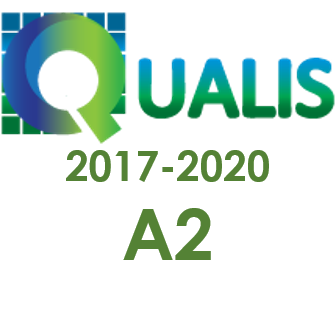Strategies for the use of visual representations in the analysis of qualitative data in QDAS
DOI:
https://doi.org/10.22481/praxisedu.v17i48.8807Keywords:
Data Visualization, Qualitative Analysis, Integrative ReviewAbstract
The so-called Qualitative Data Analysis Software (QDAS) are tools that assist the researcher in the treatment, organization, analysis, and representation of data, among others, with the purpose of supporting research analysis or scientific projects in the most diverse fields of knowledge. This article presents, through an integrative review, reflections on the strategies for the availability of visual representations in academic works that used QDAS. As a methodological procedure, the data collected between the years 2018 and 2019, from studies on Education supported by QDAS, published in Brazilian journals, with A1 quality criteria, were collected based on the Integrative Review, which allowed us to deepen the reflections of the researchers/users. of QDAS on the relationship between categorization/organization, data analysis, and data presentation together with the visual representation of data. Thus, it was intended to contribute to the theme reflections on strategies for the design of visual representations when applied to QDAS during the stages of research. From what was pointed out it was found that, when it comes to the use of QDAS as support for the visualization and analysis of qualitative data, it is necessary, initially, to consider that the integrative review allowed us to analyze that out of a universe of 2,598 articles, 70 fits and met our selection criteria, in which it was possible to verify that visual representations have the possibility to contribute in stages of scientific research and, in addition, they provide more than one strategy for their use.
Downloads
Metrics
References
ALVARES, F.; CHIRELLI, M.; PIO, D. Análise com software webQDA: perspectiva dos professores na Aprendizagem Baseada em Problemas. Revista Lusófona de Educação, 44, 83-98, 2019.
ANDRÉ, E. Reflections on qualitative data analysis software – Possibilities, limitations and challenges in qualitative educational research. Revista Electrónica en Educación y Pedagogía, v. 4 n. 6, p. 41-55. Jan/jun. 2020.
ANDRADE, L. R.; LINHARES, R. N.; COSTA, A. P.; SOUZA, F. C. Data Visualization Representations in Software Supporting Qualitative Analysis. ACTA SCIENTIARUM. EDUCATION (ONLINE), 2021. No prelo.
Biblioteca Paulo de Carvalho Mattos. Tipos de Revisão de Literatura. 2015. Disponível em: <http://www.fca.unesp.br/Home/Biblioteca/tipos-de-evisao-de-literatura.pdf>. Acesso em: 28, abr. 2021.
BOTELHO, L. L. R.; CUNHA, C. C. DE A.; MACEDO, M. O Método da Revisão Integrativa nos Estudos Organizacionais. Gestão e Sociedade, 5(11), 121-136, 2011. Disponível em: <https://doi.org/10.21171/ges.v5i11.1220>. Acesso em: 28, abr. 2021.
CAIRO, A. Infografía 2.0: Visualización interactiva de informacíon em prensa. Madrid: Alamut, 2008.
CARD, S. K.; MACKINLAY, J. D.; SHNEIDERMAN, B.; CARD, M. Readings in Information Visualization: Using Vision to Think. Morgan Kaufmann Series in Interactive Technologies, Academic Press, 1999.
COSTA, A. P.; MOREIRA, A.; SOUZA, F. N. webQDA - Qualitative Data Analysis. Aveiro - Portugal, Aveiro University and MicroIO, 2019. Disponível em: . Acesso em: 28, abr. 2021.
DICK, M. Visualizing Data To Save Lives: A History of Early Public Health Infographics. The MIT PRESS Reader, 2020. Disponível em: <https://thereader.mitpress.mit.edu/history-of-early-public-health-infographics/>. Acesso em: 28, abr. 2021.
FREITAS, C. M. D. S.; CHUBACHI, O. M.; LUZZARDI, P. R. G.; CAVA, R. A. Introdução à Visualização de Informações. Revista de Informática Teórica e Aplicada, Porto Alegre, RS, v. 8, n. 2, p. 143-158, 2001.
KLEIN, E. L. Possibilidades e desafios da prática de aprendizagem colaborativa no ensino superior. Educação, Santa Maria, v. 43, n. 4, p. 667-698, out./dez. 2018.
LOPES, Ana Daniela. Teorias e boas práticas da Visualização da Informação. Dissertação (Mestrado em Multimédia) - Programa de Pós-Graduação em Multimédia Universidade de Trás-os-Montes e Alto Douro, Vila Real, p. 189. 2018.
NASCIMENTO, H.; FERREIRA, C. Uma introdução à visualização de informações. VISUALIDADES, Goiânia v.9 n.2 p. 13-43, jul/dez. 2011.
NEIL PATEL. How to Use Data Visualization in Your Content to Increase Readers and Leads. Neil Patel Blog, 2021. Disponível em: . Acesso em: 28, abr. 2021.
MACKINLAY, J. D.; WINSLOW, K. Designing Great Visualizations. 2015.
MENDES, K. D. S.; SILVEIRA, R. C. C. P.; GALVÃO, C. M. Revisão integrativa: método de pesquisa para a incorporação de evidências na saúde e na enfermagem. Texto Contexto Enfermagem, Florianópolis, v. 17, n. 4, p. 758-764, out./dez. 2008.
PEREIRA, F. P. A. Big Data e Data Analysis: Visualização de Informação. Dissertação de Mestrado. Universidade do Minho, Escola de Engenharia. 2015.
SILVA, F. C. C. Visualização de dados: passado, presente e futuro. Liinc Em Revista, Rio de Janeiro, v.15, n.2, p. 205-223, novembro. 2019.
PIZZINATO, L.; GONZÁLEZ, X. El Prácticum de Ciencias Sociales em Dos Universidades Iberoamericanas. Educação & Realidade, Porto Alegre, v. 44, n. 4, 2019.
SOUZA, F. S. C., ANDRADE, L. R. S. A.; LINHARES, R. N. Visualização de dados qualitativos na cibercultura: uma proposta de análise descritiva a partir do uso de QDAS. Artigo apresentado na modalidade oral no III Encontro de Produção e Difusão Científica do Nordeste – Enprodic 2019.
SOUZA, M. T.; SILVA, M. D.; CARVALHO, R. Revisão integrativa: o que é e como fazer. Einstein (São Paulo), São Paulo, v. 8, n. 1, p. 102-106, Mar. 2010.
SOUZA, N..; COSTA, A. P.; MOREIRA, A. Questionamento no Processo de Análise de Dados Qualitativos com apoio do software webQDA. EDUSER: Revista de Educação, v.3, n. 1, p. 19-30. 2011.
SPENCE, R. Information Visualization. ACM Press and Addison-Wesley, 2001.
SPENCE, R. Information Visualization: Design for Interaction. 2nd Edition, Prentice Hall, England, 2007.
TRAFTON, Anne. In the blink of an eye: MIT neuroscientists find the brain can identify images seen for as little as 13 milliseconds. MIT News: on campus and around the world, 2014. Disponível em: <https://news.mit.edu/2014/in-the-blink-of-an-eye-0116>. Acesso em: 28, abr. 2021.
Downloads
Published
How to Cite
Issue
Section
License
Copyright (c) 2021 Práxis Educacional

This work is licensed under a Creative Commons Attribution-ShareAlike 4.0 International License.
You are free to:
Share - copy and redistribute the material in any medium or format; Adapt - remix, transform, and build from the material for any purpose, even commercially. This license is acceptable for Free Cultural Works. The licensor cannot revoke these freedoms as long as you follow the terms of the license.
Under the following terms:
Attribution - You must appropriately give credit, provide a link to the license, and indicate if any changes have been made. You may do so in any reasonable way, but not in a way that suggests that you or your use is endorsed by the licensor.
There are no additional restrictions - You cannot apply legal terms or technological measures that legally restrict others to make any use permitted by the license.










